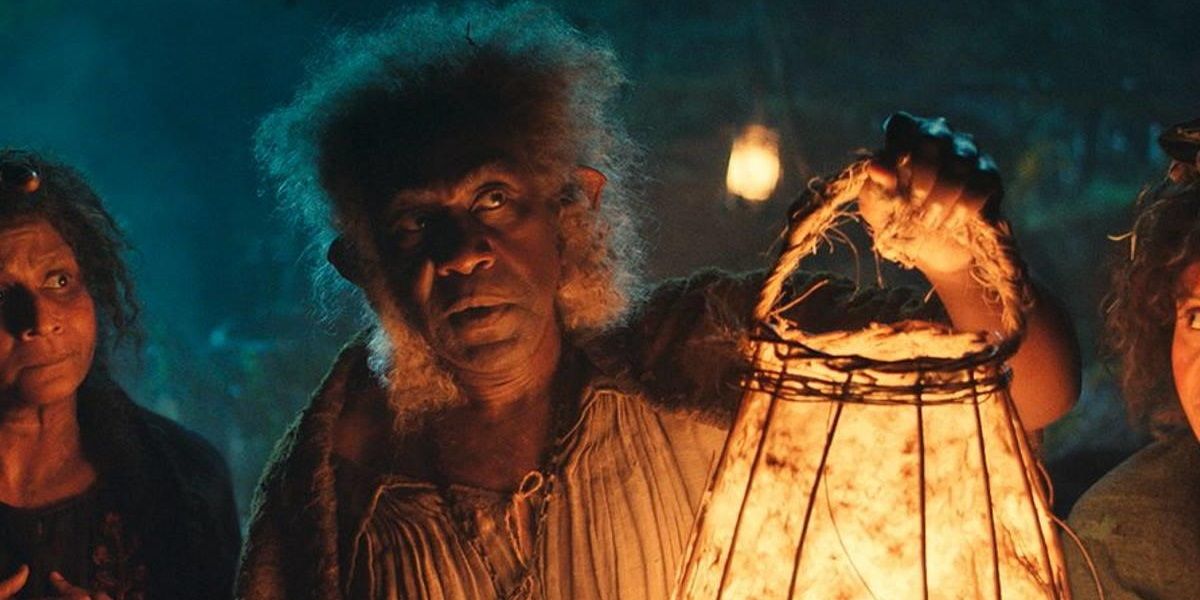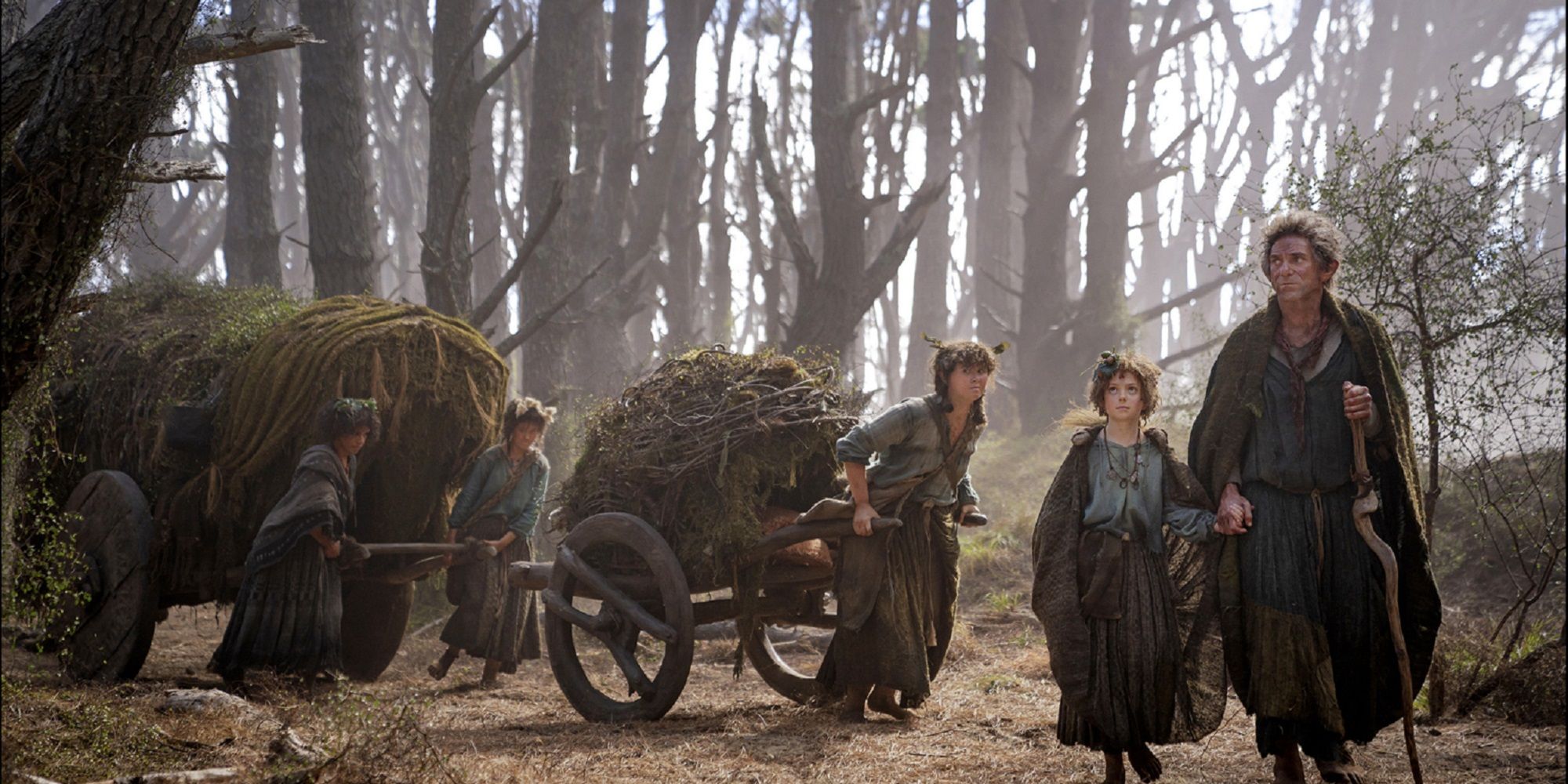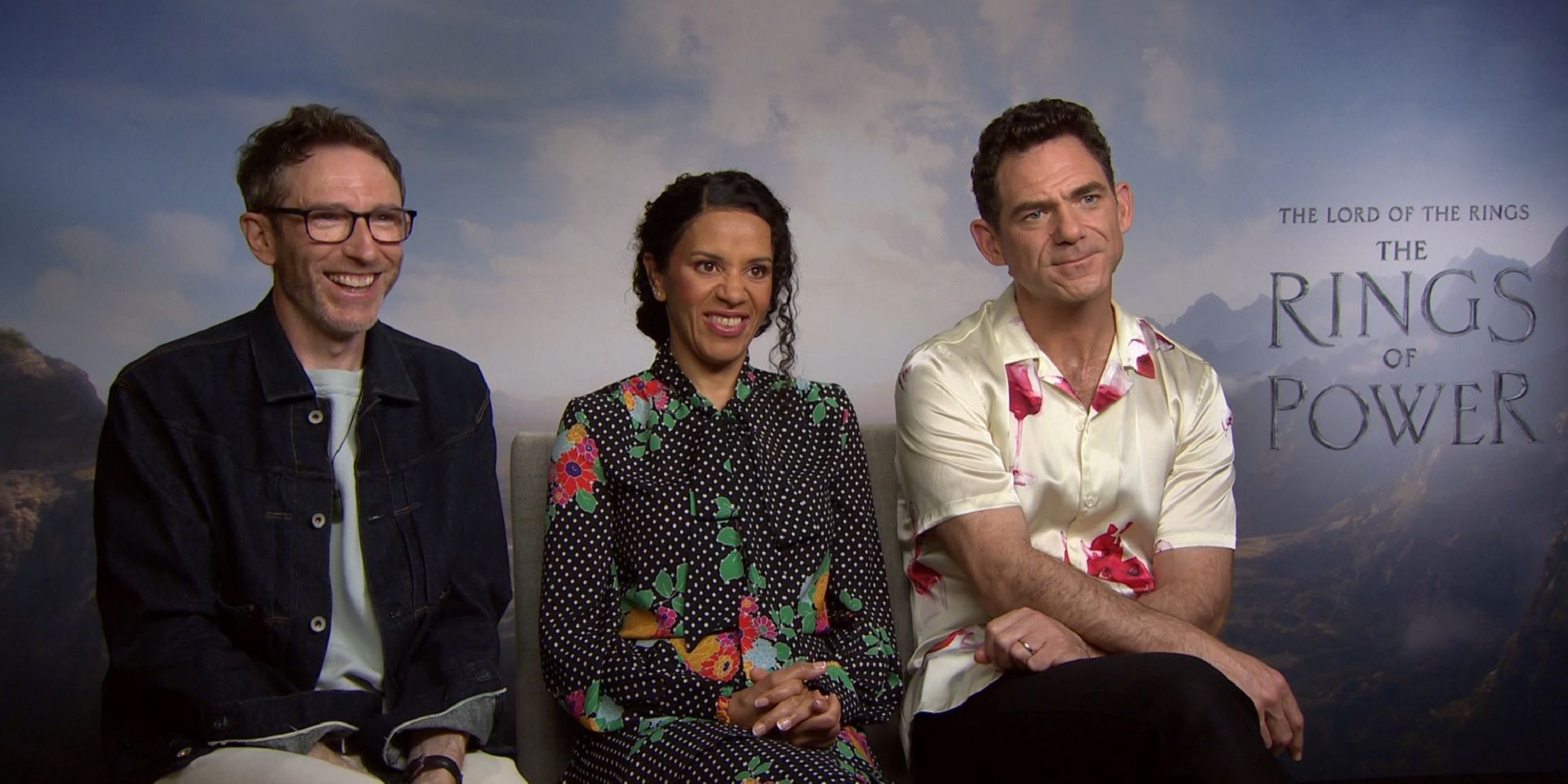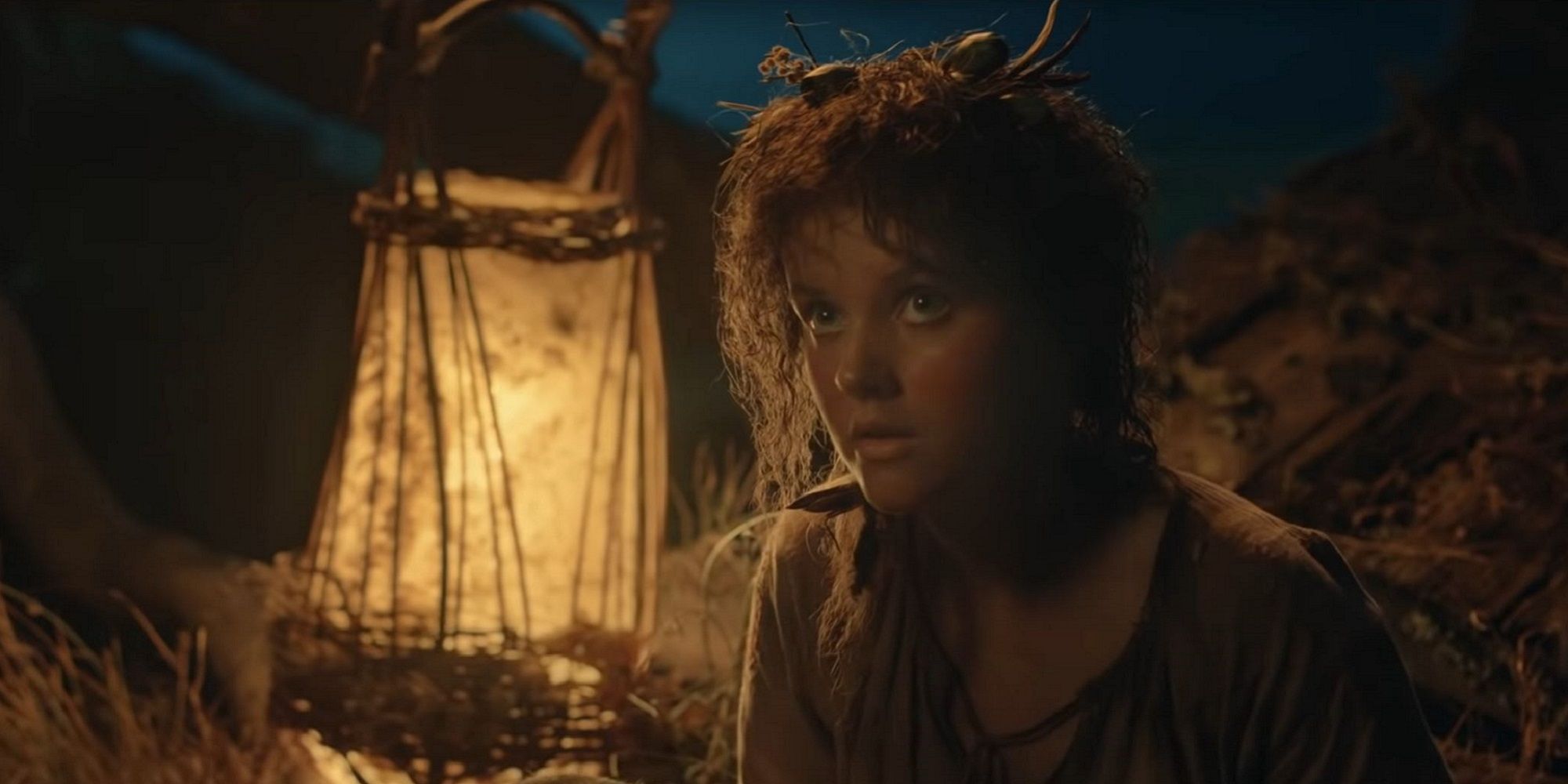As soon as the Harfoots appear on screen in The Rings of Power, you recognise that they’re Hobbits… sort of. There’s something different about them, a creepiness, a little edge. During the opening episode you learn that they, too, love their food, protect one another, and (for the most part) warn against adventure of any kind. But then that eerie edge returns, as the Harfoots hint at something darker, as if village elder Sadoc (Sir Lenny Henry) had divined it from the stars himself.
“Their entire existence is defined by their suffering,” explains Dylan Smith, who plays Largo Brandyfoot. “Staying in hiding and staying moving, because they never want to go through what they went through in the last great war. [It’s] the idea that you see that slightly rougher edge, and there's a ghost that chases them as they move, but they're still trying to keep that beautiful spirit, that heart that we see later in the Hobbits.”
While Shire-Hobbits as we know them from The Lord of the Rings try to avoid big folk, Harfoots take that to the extreme. They're a nomadic people, and every one of their tents, carts, and of course, themselves can be camouflaged in an instant. It’s hugely fun to watch, and strangely reminiscent of Robin Hood: Prince of Thieves’ Merry Men. However, among the mossy canvases and carefully hidden homes, there’s a level of detail that can’t be entirely taken in upon first viewing.
“They're very much their own thing,” explains Megan Richards, who plays a young Harfoot called Poppy Proudfellow. “And that was how it was pitched to us as well, in the meetings that we had with JD and Patrick [the showrunners, who you can read our interview with here]. The only thing that they said was that they are ancestors to the Hobbits, but that was the only reference really, so it was really nice to be able to really build the world.”
And build the world they did. “It was such an immersive experience,” explains Sara Zwangobani, who plays Marigold Brandyfoot. “I’ve loved fantasy since I was a girl – and Tolkien got me on the road of loving fantasy. It felt like a giant cosplay made especially for me, I just stepped into it, and half the work was done for you [because] it’s so beautifully detailed.”
Sir Lenny Henry also had a fondness for a particular piece of his costume, a hat that has fronds of grass attached to the top. It looks like it’s just a quirky piece of headgear, but like most of the Harfoot sets and costumes, it has a practical purpose, too.
“I had a grass hat, so when there was a problem or somebody was coming towards us, a predator, I would just go like this behind a rock [he acts out crouching down], and it just looked like there was grass growing out of the rock,” he explains, making elaborate hand gestures to mimic the grass hat sticking out above the imaginary rock in our interview room. “And I thought it was ingenious. So anything that helped us to blend in with our scenery was [great] for me, in terms of clothing. It was all thought of way before, but to see it working during a big scene was wonderful.”
Markella Kavenagh, who plays the lead Harfoot, Elanor ‘Nori’ Brandyfoot (daughter of Marigold and Largo) and Richards, whose Poppy Proudfellow acts as a reluctant sidekick, both point to the apple seeds woven into the Harfoots’ costumes as their favourite detail.
“Every single member of the Harfoot community has them,” explains Kavenagh, pointing out that you might not notice them on your first watch. “Some of the elders have more because they've lost more – [the seeds] represent a member of the community that has passed away with each migration. So I love that because it really unifies the Harfoot community in a way that's quite specific to us.”
The attention to detail doesn’t end there, either. All of the Harfoot carts are bespoke, crafted by the family that pulls them. Each one has a unique weaving pattern that means something to the family that handcrafted it and pulls it on every migration. “It unifies the community as a whole,” says Richards. “Then seeps in that sort of individuality within it.”
“Everything, and I mean everything, was practical,” adds Smith. “Our costumes worked to actually hide us. The carts were fully functional, the wheels moved, we actually pulled those very same carts that you see beds inside them. We begin the show camped out momentarily, and when migration happens, we literally packed up the set and started moving.”
The Harfoot community is shaken by ill omens and malevolent portents, however, which manifest as a meteor crashing down to Middle-earth near their dwelling. At the centre of the fiery crater is The Stranger, a tall, babbling man who seems to have forgotten everything about who he is and what he’s doing. As I noted in my review, Daniel Weyman’s physical performance in the early episodes is impressive, and we watch The Stranger move like a contortionist as he tries to wrestle with his own body (Smith describes him as “a creature coming into existence”).
“I was quite worried about [keeping The Stranger’s true identity a secret],” says Weyman. “But I think the longer it's gone on, and because we had to immerse ourselves in New Zealand, which was an amazing experience let's not forget, and then the world locked down, actually, there wasn't a huge amount of secrecy because we were in such a tight bubble. And the work was so detailed and specific, I was actually able to play quite a lot of truth and the scenes very honest. And I felt that there wasn't a sort of plot device aspect to this character.”
Whether or not he’s based on a niche Tolkien poem we don’t yet know, but Nori Brandyfoot is similarly intrigued by the meteor man – she’s an adventurous and meddlesome Harfoot, the Bilbo Baggins of their kind, if you will.
At one point she brings The Stranger a bag of large snails to eat – they’re a staple of the Harfoot diet, apparently – despite the constant warnings of ‘stranger danger’ instilled into her by her fellow halflings. As so much of The Rings of Power is practical effects, I had to know exactly what Kavenagh and Weyman were eating on set.
“They were made of this jelly, gelatin kind of base, but they've covered them in syrup so they were very sweet,” Kavenagh explains, accompanied by a loud groan of disgust from Henry to her left. It’s unclear as to whether he doesn’t like jelly or it was the idea of slurping giant snails that brought it on, but Kavenagh presses on. “It was really weird going to ADR and then seeing the effects that they'd done so they looked like they were moving around. And then Daniel [Weyman] ate the shells, which are made out of this beautiful chocolate for ages, and I was just eating this really sweet jelly.”
Jelly, however sickening, has to be better than actual snails though, and the levels of detail in this production – from the Harfoot camp to Celebrimbor’s workshop in Eregion complete with Fëanor’s hammer – mean that I wouldn’t have been overly surprised to hear that they’d used actual snails. But it’s not all snails and pigberries for the Harfoots, as a dark sense of foreboding is slowly creeping up on them, the stars are misaligned, and things may not be as they seem.
Wolves are circling the camp, The Stranger’s identity and level of threat are as yet unknown, and there’s a festival to be hosted before the migration. This feels likely to happen in the next few episodes, and the teasers suggest that it will ramp up the folk horror vibes of the Harfoots to near-Midsommar levels. The Harfoots may be defined by the suffering in their past, but it doesn’t seem like the future is going to be all jelly snails and chocolate shells.
Source: Read Full Article
.jpg)



